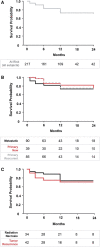Laser Ablation of Abnormal Neurological Tissue Using Robotic NeuroBlate System (LAANTERN): 12-Month Outcomes and Quality of Life After Brain Tumor Ablation
- PMID: 32315434
- PMCID: PMC7534487
- DOI: 10.1093/neuros/nyaa071
Laser Ablation of Abnormal Neurological Tissue Using Robotic NeuroBlate System (LAANTERN): 12-Month Outcomes and Quality of Life After Brain Tumor Ablation
Abstract
Background: Laser Ablation of Abnormal Neurological Tissue using Robotic NeuroBlate System (LAANTERN) is an ongoing multicenter prospective NeuroBlate (Monteris Medical) LITT (laser interstitial thermal therapy) registry collecting real-world outcomes and quality-of-life (QoL) data.
Objective: To compare 12-mo outcomes from all subjects undergoing LITT for intracranial tumors/neoplasms.
Methods: Demographics, intraprocedural data, adverse events, QoL, hospitalizations, health economics, and survival data are collected; standard data management and monitoring occur.
Results: A total of 14 centers enrolled 223 subjects; the median follow-up was 223 d. There were 119 (53.4%) females and 104 (46.6%) males. The median age was 54.3 yr (range 3-86) and 72.6% had at least 1 baseline comorbidity. The median baseline Karnofsky Performance Score (KPS) was 90. Of the ablated tumors, 131 were primary and 92 were metastatic. Most patients with primary tumors had high-grade gliomas (80.9%). Patients with metastatic cancer had recurrence (50.6%) or radiation necrosis (40%). The median postprocedure hospital stay was 33.4 h (12.7-733.4). The 1-yr estimated survival rate was 73%, and this was not impacted by disease etiology. Patient-reported QoL as assessed by the Functional Assessment of Cancer Therapy-Brain was stabilized postprocedure. KPS declined by an average of 5.7 to 10.5 points postprocedure; however, 50.5% had stabilized/improved KPS at 6 mo. There were no significant differences in KPS or QoL between patients with metastatic vs primary tumors.
Conclusion: Results from the ongoing LAANTERN registry demonstrate that LITT stabilizes and improves QoL from baseline levels in a malignant brain tumor patient population with high rates of comorbidities. Overall survival was better than anticipated for a real-world registry and comparative to published literature.
Trial registration: ClinicalTrials.gov NCT02392078.
Keywords: Brain tumor; LITT; Laser ablation; Quality of life; Survival.
© Congress of Neurological Surgeons 2020.
Figures





References
-
- Kamath AA, Friedman DD, Hacker CDet al. .. MRI-guided interstitial laser ablation for intracranial lesions: a large single-institution experience of 133 cases. Stereotact Funct Neurosurg. 2017;95(6):417-428. - PubMed
-
- Rennert RC, Khan U, Tatter SBet al. .. Patterns of clinical use of stereotactic laser ablation: analysis of a multicenter prospective registry. World Neurosurg. 2018;116:e566-e570. - PubMed
-
- Rennert RC, Khan U, Bartek Jet al. .. Laser Ablation of Abnormal Neurological Tissue using Robotic NeuroBlate System (LAANTERN): procedural safety and hospitalization. Neurosurgery. 2020;86(4):538-547. - PubMed
-
- Abu-Hegazy M, El-Hadaad HA. Neurocognitive effects of primary brain tumors. In: Agrawal A, ed. Neurooncology - Newer Developments. London: InTech; 2016.
-
- Chang SM, Parney IF, McDermott Met al. .. Perioperative complications and neurological outcomes of first and second craniotomies among patients enrolled in the glioma outcome project. J Neurosurg. 2003;98(6):1175-1181. - PubMed
Publication types
MeSH terms
Associated data
Grants and funding
LinkOut - more resources
Full Text Sources
Medical

